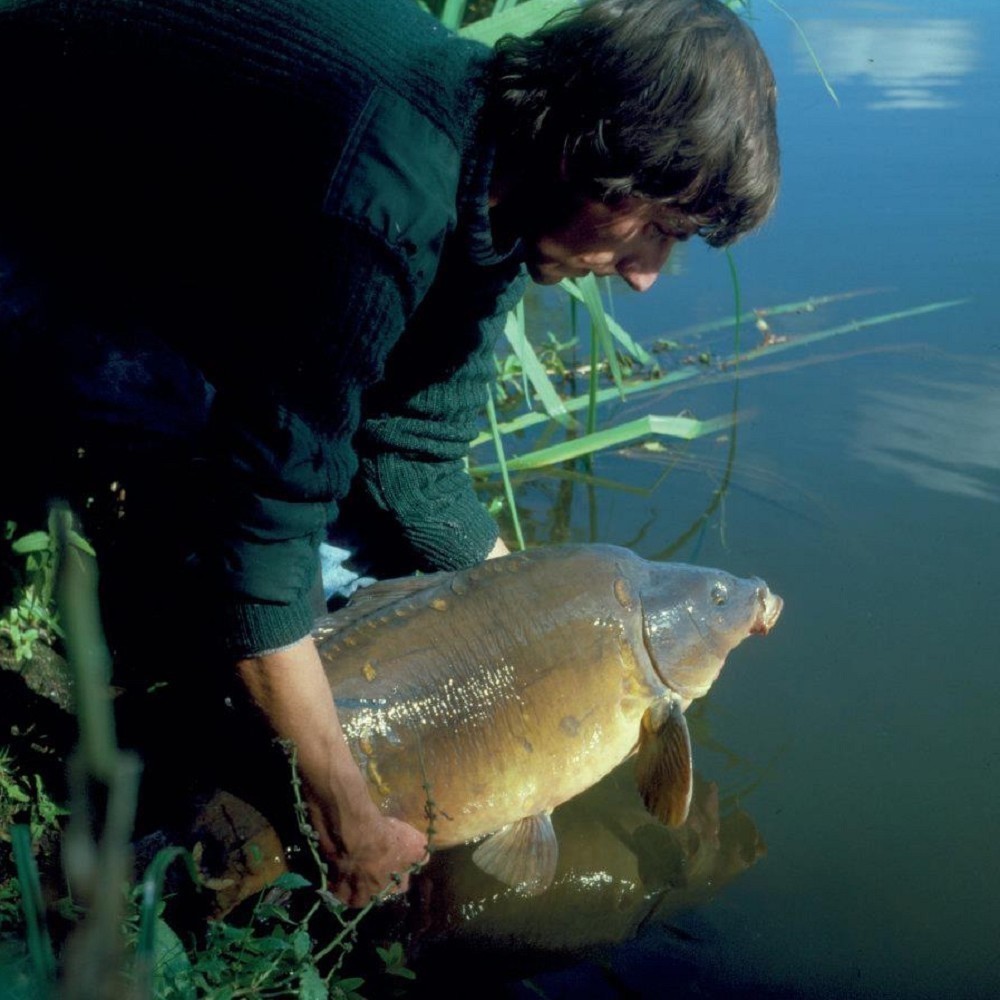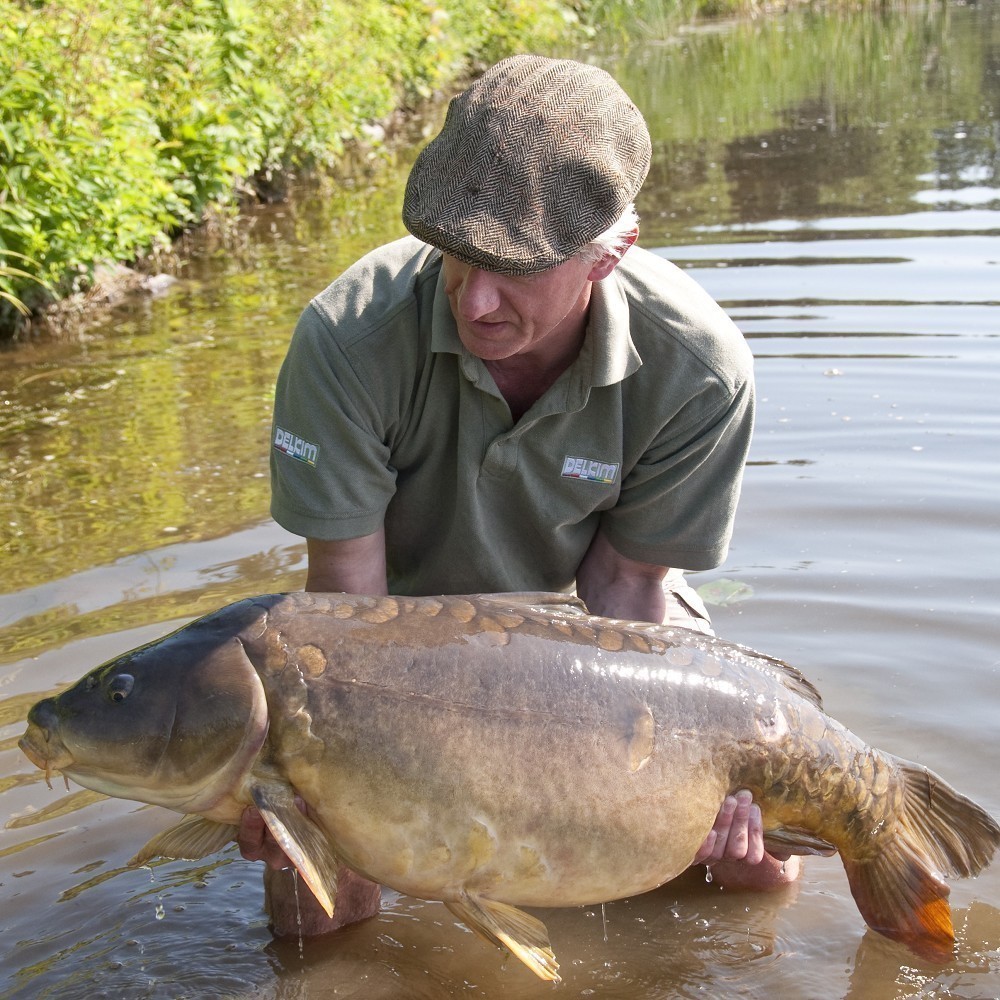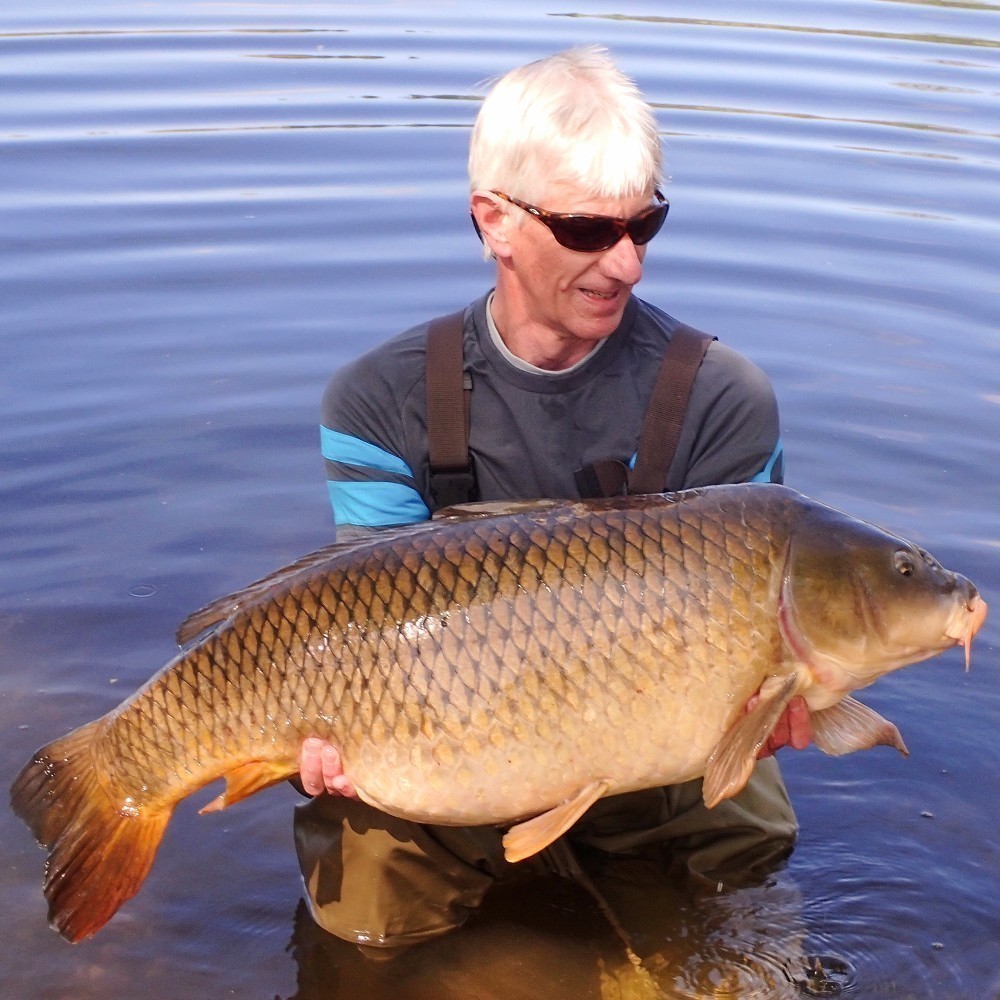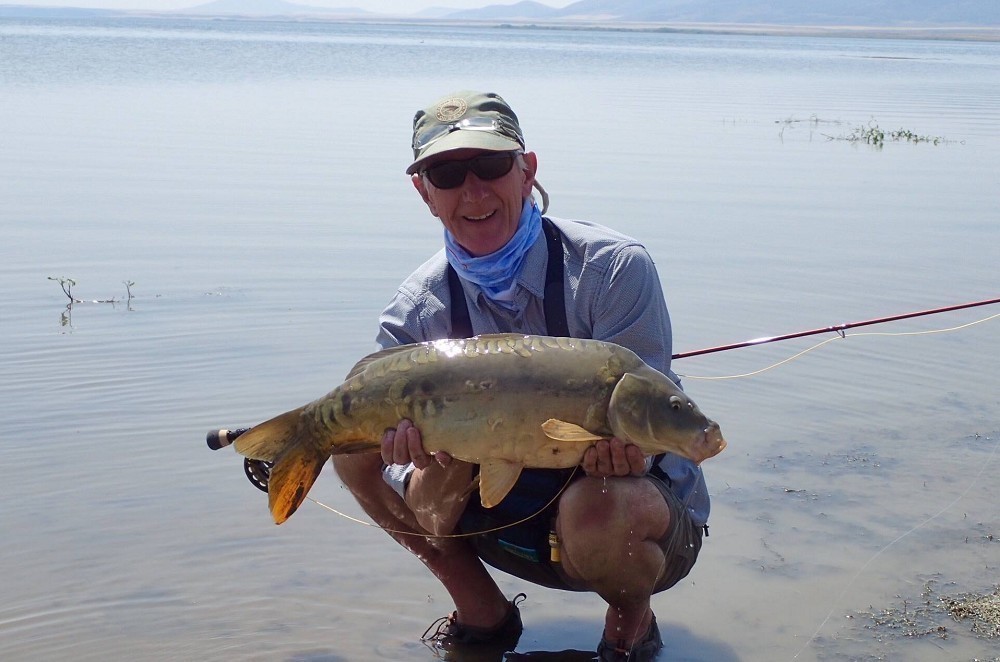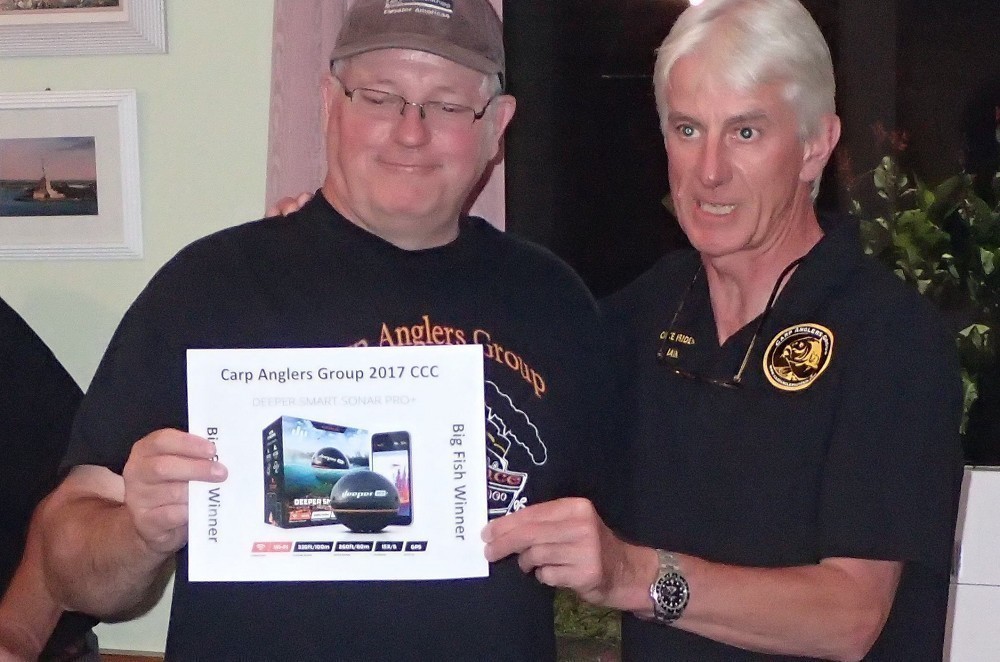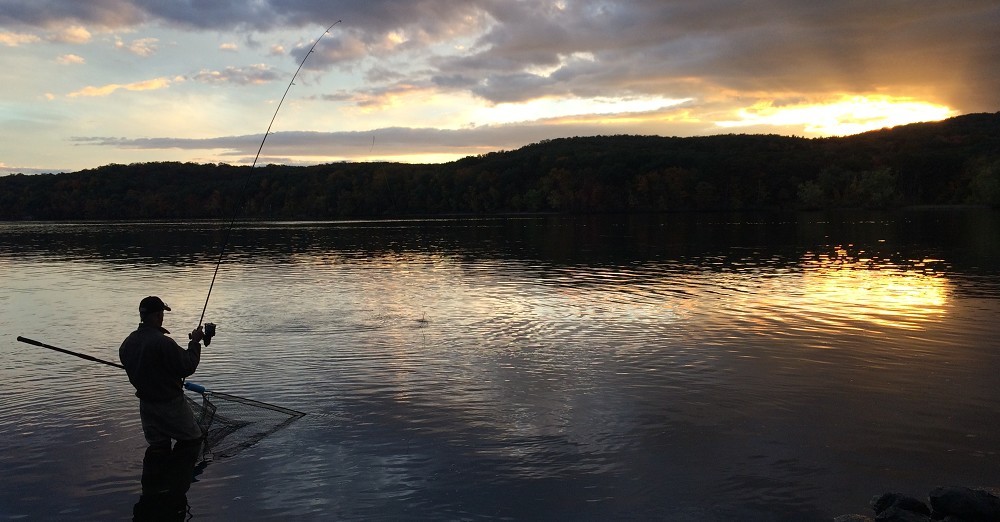
Carp Letter from America: November 2018
Simon Blanford and Andy Bell let us know what they've been up to this month...
Since we've been putting Carp Letter from America together we've tried to find carp fishing topics from here in the States to help give readers an insight (undoubtedly a little skewed as it comes from our own fallible perspective) into various aspects of American waters, style of fishing, boats, the waters, the boats etc. etc. This pads out the column which mainly deals with our less than stellar fishing results. For a while we've thought about getting some American carp fishers and those involved in carp fishing here to add their two cents worth for the column. It hasn't happened in the last few years we've been writing this tripe mainly because we're too disorganised. But now we have done something about it. This month we’ve burnt the midnight budgie to bring you an interview with the current President of the Carp Anglers Group of America (CAG) Iain Sorrell.
Carp Letter from America: Let's start with some background before we get into your role with the Carp Anglers Group. Where and when did you get into fishing and then fishing for carp in particular?
Iain Sorrell: My mum grew up in Northumberland near the border with Scotland and her brother had been a serious fly fisherman on the Tweed. So the first time I wet a line was on the Grand Union canal aged 4 (some 57 years ago!) using a Hardy Palakona split cane fly rod albeit with a float attached. My only memory from that day was the float going under and my mum helping me to strike. Rather enthusiastically, as it turned out, with the small roach being sent over our heads and into the bushes behind… not exactly my finest catch and release moment! My first carp was caught while float fishing the local park pond in my hometown of Chesham. I was probably aged around 9 or 10. When I was 12 I remember going to a friend’s house in Folkestone and his grandfather taking us to nearby lake. We’d seen carp cruising up and down a line of reeds so I cast out a ledgered crust. I vividly remember seeing the crust inhaled by a good sized carp but by the time I’d picked up the rod it had dropped the hook. It was all a bit hit or miss in those days!
CLfA: Just because Simon used to fish floating crust a lot in his youth to the carp in his local farm ponds he wondered whether you had ever reverted and tried to catch, or had indeed caught a carp here on floating crust?
IS: A freelined floating crust is still one of my favorite baits and very effective over here in the USA. It’s a no brainer in any public park that holds carp and where folk feed the ducks! It can take a bit of effort to get carp interested if they’ve not seen bread on the surface before but well worth it. I’ve also caught some very big grass carp on floating crust including two fifties and one that banged my 60lb Reubens down hard against the stop!
CLfA: You fish for other species too, I think we've seen mentioned that you like fly fishing, but what was it about fishing for carp that attracted you in the first place?
IS: The Colne Valley was only a tube and a bus ride away so from about 1970 I became a member of North Harrow Waltonians who, like many local angling clubs, had an active carp stocking program on their Springwell lake. In those days I was really more focused on catching big pike, tench, roach and chub. Then after college (1977) when carp began to feature more regularly in the Angling Press and I started to try and catch a few. But those early efforts were pretty half hearted to be honest.
CLfA: We read that you fished Savay at the beginning of the eighties just as it became famous. Were you heavily into the carp scene in the 1980s and if so what did you think of it and where did you fish?
IS: In 1978 I met Mike Wilson (of baiting pyramid fame) at a friends house warming party and he suggested that if I really wanted to give carp a more serious go then I’d do well to join Ruslip AC who had the fishing rights on Savay. Now in those days you had to apply to join the club and Mike warned me that I would need to serve an ‘apprenticeship’ which involved going to a few ‘away’ matches (coach trips to the Thames and so on) as well as putting in time at working parties. Any mention of being interested in carp would likely get you turned down so it wasn’t until the Fall of 1979 that I got to fish with Mike, who as everyone now knows had had some incredible catches from Savay. Those early sessions focused on particles but then Mike came running down the bank one morning holding up a rig (given him by Lenny Middleton no less) with the bait suspended two inches below the hook on a piece of 2lb mono! Almost overnight we began making boilies using basic ingredients (mostly semolina based). I’d discovered belachan a couple of years earlier and Mike and I figured that as we’d caught some nice chub on it then it would likely be a good carp bait.
In 1980, Redlands, the owners of Savay, were persuaded to allow a syndicate to be formed with access to limited areas of the lake. The syndicate read like a ‘who’s who’ of carp fishing! Andy Little, John Baker, Lenny Middleton, Rod Hutchinson and so on were lined up along the canal bank while Ruslip still maintained exclusive access to the island swims.
Mike and I were also ‘bailiffs’ for Boyers in those days. This gave us access to fish Harefield, Rodney Meadow and Farlows along with several other waters they controlled. Almost all of which contained good stocks of carp & other species.
I’ve always been an all-round angler (both fresh and salt) so carp fishing was simply an opportunity to try my hand at another species. I never even thought about fishing through the winter for carp as my attention was then focused on big pike or catching 2lb plus roach and big chub from a syndicate stretch we had on the Kennet.
The early carp scene at that time saw some incredible innovation in both tackle and bait. It’s amazing to look back at how basic our setups were in those days. Invariably everything was homemade and often quite crudely constructed but if it worked you’d soon see a more refined version in the tackle stores.
CLfA: That’s quite a fishing pedigree. So when did you come to the States and what brought you over?
IS: My wife got an opportunity to do a 2 year assignment in Hartford, CT. Since our kids were small we decided to go for it. We arrived in June 1994 and after 24 years we are still here!
CLfA: Did you know anything about the carp fishing potential carp here before you came?
IS: Absolutely nothing! I’d thrown a fly and spinning rod in with my luggage and had to wait another couple of months for everything else to arrive. I was driving around one day looking at places to fish when I saw someone sat under a big green brolly. As luck would have it I’d just come across a fellow Brit, Nigel Griffin, who also happened to be one of the originators of the Carp Anglers Group and had a small business importing carp tackle. Nigel, like myself, is not just a carp angler but a great all-around angler. As I sat there watching him fish my passion for carp fishing was quickly reignited.
CLfA: What were your first impressions on arrival?
IS: Well it didn’t take me too long to realize that within 2-4 hours of where I was now living was some of the finest and most diverse fishing ANYWHERE in the World! Trout, Salmon (both landlocked Atlantic and Pacific species), Steelhead, Pike, Muskie, Carp, Bass and so on plus there was a whole host of saltwater species to get stuck into!
CLfA: Yes the diversity of fishing opportunities is huge here not to mention that much of it comes with the simple cost of a state license. But carp are not a popular fish so what was the reaction of other anglers when they found you were deliberately targeting carp.
IS: In those early days we were largely a curiosity and generally dismissed as such. Bank angling was almost always looked down upon and our set ups the source of some amusement especially when we told them how much most of it cost!
CLfA: Were there other dedicated carp anglers from the start?
IS: Actually there were quite a few. The Carp Anglers Group, which began in 1993, began to pull together the individuals and small local groups of dedicated carpers who were spread across the vast expanse of North America. The early internet groups took over from mailed newsletters and we got together as often as possible to fish and share knowledge.
CLfA: Has there always been a core group of carp anglers here despite the reputation of the fish?
IS: Ever since they were introduced to the USA in the 1800’s there have been carp anglers! Early settlers, especially those from Eastern Europe, would catch them for food. While many anglers grew up to despise carp there are still accounts from the 1930’s and 40’s of anglers who clearly recognized their value as a sport fish.
CLfA: Were they American or European ex-pats?
IS: Those who are more recent immigrants or grew up with carp fishing on Pay Lakes are already on board. But it can take some persuading for anyone who’s family has been here a couple of generations or more and was weaned on the folklore of carp as a threat to native species to appreciate their sporting potential with rod and line.
CLfA: You mentioned Pay Lakes. Gaz Fareham used the term in the August edition of CARPology last summer to describe some of the commercial carp lakes in France. We wrote very briefly about them a couple of months ago too. Can you tell us something about Pay Lakes here? Have you spent anytime fishing them?
IS: Paylakes in the USA are nothing like the commercial or day ticket carp lakes in Europe. In most cases they are 1-2 acre ponds with fishing stations or pegs around the perimeter. The term Paylake refers to the cash ‘pay outs’ that are made at regular intervals during the fishing sessions or tournaments that take place usually on a weekly basis. The carp and catfish that are stocked at regular intervals invariably come from lakes or rivers fished by non-paylakers (aka wild water anglers) which clearly creates some tension particularly when specimen fish are being moved. There has been a lot of discussion, especially among ‘euro’ style carp anglers, about the conditions and treatment of fish in some paylakes. Some of the practices (‘juicing’ the water with copper sulfate, supposedly to kill off weeds, is also used to stimulate feeding ahead of tournaments) are clearly detrimental to the water and fish health. There are some great paylake anglers who are now engaged in ‘wild water’ fishing and their application & success with pack baits is quite eye opening. A number of these anglers have also been supportive of improving conditions and handling of fish at several paylakes.
CLfA: Back to your fishing, over the years have you made many changes to the way you fish? Do you adopt the latest developments from across the water or do you find that American carping doesn't need the latest rig and bait tweaks?
IS: I think I’m fortunate that I got to fish in the pre hair-rig era and without the incredible range of advanced tackle that’s now available. As with all fishing it’s really more about first using your observations and knowledge to locate fish and then determining the most effective approach to catch them. A simple, well tied rig with good presentation and mechanics is all too often overlooked (on both sides of the pond). It is the same with bait. I often fish particles or method because they are not only inexpensive (especially for large baiting campaigns) but also devastatingly effective. In some key waters there is no doubt that good quality boilies will deliver the results. When used correctly they can help to separate out the bigger fish. I’m always intrigued by the latest innovations or ideas and always like to try things out. In the end, if it doesn’t work the way I would like then I soon find myself going back to basics.
CLfA: We’ve heard this before, boilies sort out the bigger carp, but, being scientifically minded we haven’t seen anything that really supports this view. Is it your own experience that this is the case and why do you think it is more likely that you’ll catch a chunk on a boilie rather than particles?
IS: Well let’s consider this in two parts. First we have to thank a Kent docker who in the 60’s & 70’s developed an interest in chemistry and fish nutrition. Fred Wilton concluded that a high nutritional value (HNV) food source would likely be favored over others and he began to develop baits (pastes before the boilie era) with this in mind. The success of his baits and the catches that resulted, especially over long periods without the bait being ‘blown’, have been well documented. The second part is, I believe, down to the manner in which boilies are fished compared with particles. Particles or mass baits are invariably fed over a small area to entice competition between feeding fish. Boilies on the other hand are typically spread over a larger area which encourages fish to roam around in search of the next morsel. So bait quality is always a primary consideration (how many commercial baits exploit the HNV aspect over instant attraction?) but I also believe that individual big fish feeding behavior is complemented more by a boilie approach than competitive feeding over particles. It also helps that they are not in close proximity of other fish (being hooked) so there is less chance of them being spooked.
CLfA: Have you noticed the carp "wising up" in any of the waters you target from the pressure you or others have exerted on them?
IS: This is really an interesting question and one that many over here disagree on. If you could imagine having almost all the UK carp waters available to you, without any restrictions on access and perhaps only 50 carp anglers in the entire country then that gives you some idea how it is here in the USA! For the most part there is very little pressure on the majority of carp waters but what does often happen is that a particular swim or area can attract a lot of attention. So yes, in my experience, the carp can and do ‘wise up’ but not in the same way as the UK or Europe. I certainly don’t think they become as ‘riggy’ but since they are not dependent on anglers bait and often have access to huge expanses of water they will avoid or become more difficult to catch in some areas.
CLfA: Yes, this makes a lot of sense. We have fished one area of a particular lake hard over the last four or five years and the fish have simply evaporated. It’s one of the things that’s most striking here – the size of the lakes and reservoirs and how much water the fish can disappear into. Do you pay attention to this in any way? For example, do you fish a place hard and then move or fish an area lightly try and keep it producing?
IS: There is little doubt that too much pressure in a swim can seriously impact the catch rate. A few years ago a section of the CT River attracted a lot of attention as a result of some extraordinary catches. There were even people sitting behind those fishing waiting to move in! The catch rates in this section fell off but those who were a bit more adventurous and searched out new areas continued to do quite well. For many years my fishing was limited to shorter 4-6 hour sessions and ensuring the fish would be in the swim to match my schedule was critical. I had some spectacular results and one of the keys I believe was being able to continually bait two or three swims (on different waters) and rotate my time on them.
CLfA: Aside from the fishing are the carp themselves different here? Obviously they are less pressured and many live in much larger waters. Does this affect their behavior, affect what they might feed on, where they might be found?
IS: There have been no formal stockings (except for Israeli carp that were commonly sold as live bait) since the original carp introductions almost 200 years ago. As a result common carp are the predominant scale pattern but in some key waters you can find a very high proportion (sometimes exclusive) of mirrors often with stunning scale patterns. Here in Connecticut we have seen an incredible number of ‘fantail’ carp in recent years. These dramatic looking fish are clearly the result of goldfish or koi being released and crossing with the local carp population. In North America carp rely almost entirely on natural and seasonal food sources. As a result carp will often ‘roam’ a lake or section of water following the tides, wind and the availability of various food sources. We often see local differentiation in size, shape and color as well some adaptation to the primary food sources. There are some with big heads and hard mouths because they primarily eat clams and mussels buried in dense sand or silt. Long lean commons that are adapted to chasing bait fish or crayfish or shorter, fuller bodied fish that feed mostly on bloodworm.
CLfA: That’s a point probably little appreciated in the UK because so many waters are stocked but there is a significant amount of research on how fish can specialise in their feeding habits and how that leads to different body shapes and, as you say, general behaviour. Do you think there may be individuals, or feeding specialists that largely go uncaught here simply because it is difficult to, to steal a fly fishing term, “match the hatch”, of what the fish is specialising on?
IS: There are certainly some very elusive carp in the UK that can go uncaught for years at a time while others come out on a regular basis. These elusive fish must continue to feed but if not on angler baits then it can only be natural sources. The question perhaps is have they learned to avoid an angler’s bait or have they simply never considered it as a food source? In the tidal sections of many US East Coast rivers carp are often caught on eel or fish chunks and even on big rubber lures by striped bass fishermen so perhaps we need to rethink some approaches!
CLfA: You wrote a great piece for Big Carp News (bigcarpnews.com) on the potential size of carp here in the US. Can you summarise that for us here - how big do you think carp grow in American waters and are there particular areas of the country known for their bigger fish or does it seem they are fairly well spread across the States?
IS: Everyone hopes there might be fish here matching those in Europe but sadly I think a 60lb plus carp is a very rare beast indeed. We’ve only seen Louis Montes recent fish from California and a couple of bowfished specimens plus a few over 50lb that have been caught in the past 25 years. There are clearly waters and regions that consistently produce good numbers of thirties and occasional forties such as the North Eastern States, Michigan, Texas and California. In the end we have so much water and so few carp anglers it could take decades of fishing to find individual big fish.
CLfA: Is there anything about the waters you have identified as consistent producers of the largest carp that sets them apart from waters that say, produce a lot of carp but many in the teens or twenties?
IS: When you look at the history, tiny size (approx 3 acres) of the UK’s Redmire and the incredible fish it once produced it gives us some clues on what to look for. Small populations of larger than average carp, plenty of natural food, stream or river fed, clean water, shelter in the shape of weed or lilies and limited access by larger predators (human or otherwise…). Here we have water systems in some mid west states that are overrun with smaller carp because the spawning areas are too low in oxygen (mostly due to agricultural run off etc) for predatory fish species to exist. This results in way too many carp fry reaching maturity leading to stunted growth and over population. Conversely areas like New England where the carp spawn and fry are heavily predated upon by pike, perch, bass etc results in fewer carp reaching maturity. So ultimately clean, clear waters with lots of natural food as well as a healthy population of predatory fish will always be a bright spot on my radar!
CLfA: The Carp Anglers Group of America is probably the most prominent organisation here for carp anglers. How long have you been associated with it?
IS: We are currently celebrating CAG’s 25th anniversary. I joined back in late 1994 or perhaps early 1995.
CLfA: Have you noticed any changes over those years - has the membership grown or is it fairly stable. And have the topics discussed on the forums changed at all?
IS: As with many organizations there have been many changes over the years not least with the growth and impact from social media along with the ease of accessing information via the internet. However I’m delighted that we have seen a significant growth (over 40%) in membership in the first six months of 2018. As for changes in forum discussion that is probably much the same (the usual how to questions on baits and tackle or where to fish) but with many more conflicting answers!
CLfA: As we mentioned up top you are now President of CAG. Was this your choice or were you persuaded to take on the role?
IS: Well ultimately it was my choice. I believed that there was a lot I could contribute to CAG as President and to help lead it forward at a time when it was most needed.
CLfA: What do you see as your main tasks for CAG while you are director?
IS: CAG is a not for profit organization and is guided by its mission. The fundamentals of that mission are to help people learn more about carp and carp fishing, to practice catch and release, especially of trophy carp and to get out to fish and have fun. It’s pretty simple really and everything else revolves around those goals. We help facilitate local fish-ins & socials, run tournaments like the St Lawrence Junior, CCC & ATC, organize Big 4 competitions, Discovery week, and started the North American Carp Conference which we hosted in Connecticut the past two years.
CLfA: Our, admittedly limited, experience talking to those in charge of fishing in our state indicates that they know very little (if anything at all) about carp and aren't really interested in them as a sport species. Have you found that to be the case more generally?
IS: It varies widely. Some are aggressively anti carp while others (like CT and TX) are much more open minded and beginning to consider or even introduce regulations that are geared towards catch and release of trophy fish, at least on some waters.
CLfA: Across the world carp are seen in very different ways - revered in Europe, hated in Australia for just for one comparison. Any wider promotion of the fish has to take into account that they can be destructive pests and are thought to be such in a number of states, particularly in the Midwest. How do you and CAG reconcile this dichotomy - carp as a sport fish and carp as an invasive pest?
IS: I mentioned earlier that in some areas, carp have become over populated. The science mostly points towards anoxic breeding marshes where carp fry can grow unmolested by predatory fish such as pike, perch, sunfish or bass. In other areas, such as New England, we simply don’t have that problem. All too often carp become the scapegoat for the real underlying problems and are then blamed for water quality issues or loss of native species. The real culprits are water abstraction and dams that result in silting of rivers and higher water temps as well as agricultural run-off that leads to excess nutrients and so on and so on. So for CAG it is important to help dispel any myths while focusing on the protection of trophy sized fish.
CLfA: We mentioned Pay Lakes earlier. They may be an established kind of fishery here and a relatively old form of fishing for carp but, at least from a European perspective the carp handling and care leaves something to be desired. CAG has a mission to promote carp fishing obviously but also to treat carp with respect. How does CAG reconcile the way carp are handled at Pay lakes and the stated mission of the group?
IS: CAG has always been about inclusivity and helping others. No one wants to see a fish mistreated or kept in terrible conditions. Even a carp lying on the grass instead of a mat (a relatively new invention when you look back to photos of UK carp captures before the 1990’s) or not being held correctly can bring about a torrent of abuse on social media. If we want to grow carp fishing in North America and generate more respect and care for them we all need to encourage and educate folk instead of trying to alienate them.
CLfA: Wild fishing through pay lake fishing and on to bow fishing can be seen as a continuum in terms of each discipline showing a declining interest in the carp of and for itself. Bow fishing is a popular ‘sport’ here and carp are a regular target of bow fishers. For the CARPology readers could you describe what bow fishing is and how they deal with the fish they target?
IS: The concept is all too simple… take a bow (usually a high performance compound bow) and attach the arrow (with a barbed head) to a spool of 80-100lb braided line. Go out at night (mostly) on a boat equipped with high intensity LED lights and shoot the carp in 2 – 5’ of water. As you can imagine this is a very emotive issue for any serious carp angler. There is NO catch & release in bowfishing and ultimately they target the biggest fish. A single boat with 2 bowfishermen can easily KILL 50-80 carp in a single night during the spawning season. A single 2-3 day tournament might kill 3,000 to 6,000 lb of carp with many of those fish over 20 or even 30lb.
CLfA: Does CAG have a view on the practice given that the end result of bow fishing for carp is diametrically opposed to catch and release and any nurturing of the ‘trophy’ (specimen) carp.
IS: Absolutely. CAG has no issue with anyone who wants to take an occasional small fish for the table (that’s the American ‘way’). But the wanton killing of trophy sized fish (which also includes native gar and buffalo as well as other illegally killed species such as pike and muskie) demonstrates a level of behavior that is completely alien to almost every angler, hunter or sports person. Especially when the fish killed are invariably ‘thrown’ back in the water, left along the dock or road side, or at best dumped in fields for fertilizer.
CLfA: Among carp anglers this practice always raises hackles. Clearly there may be an ethical argument about the pasttime but is there any evidence that bow fishing actually impacts carp populations?
IS: When bowfishermen complain that they can no longer shoot big fish and then set self imposed limits on the size of fish they can shoot it then becomes self evident that they have created the problem. The real joke is they claim to be helping the environment by shooting carp while in reality their actions lead to bigger populations of smaller carp that ultimately cause more issues. So yes they can & do severely impact the numbers of big carp.
CLfA: Carp fishing has expanded its horizons considerably from the time of BB, Walker, Beechmere and Redmire. Carp anglers are now prepared to spend considerable amounts of money traveling to carp fishing destinations. Do you think America could be one of those destinations in the future (noting that the St Lawrence fishery is already a venue for overseas anglers)?
IS: The St Lawrence has already hosted 2 or 3 World Championship events and Paul Hunt in Canada welcomes visiting anglers to his section of the river every year. We see a steady stream of anglers coming over to fish key locations and eager to add a specimen buffalo ‘carp’ to their list. There is a lot to offer the visiting carp angler, not least the incredible scenery, diverse locations and numbers of fish. There is however a lot of choice and competition within easy (driving) access to top quality European fisheries.
CLfA: What advice would you have for anyone from Europe considering coming over to America to do a bit of carp fishing either as a dedicated holiday or tacked onto a business or family trip.
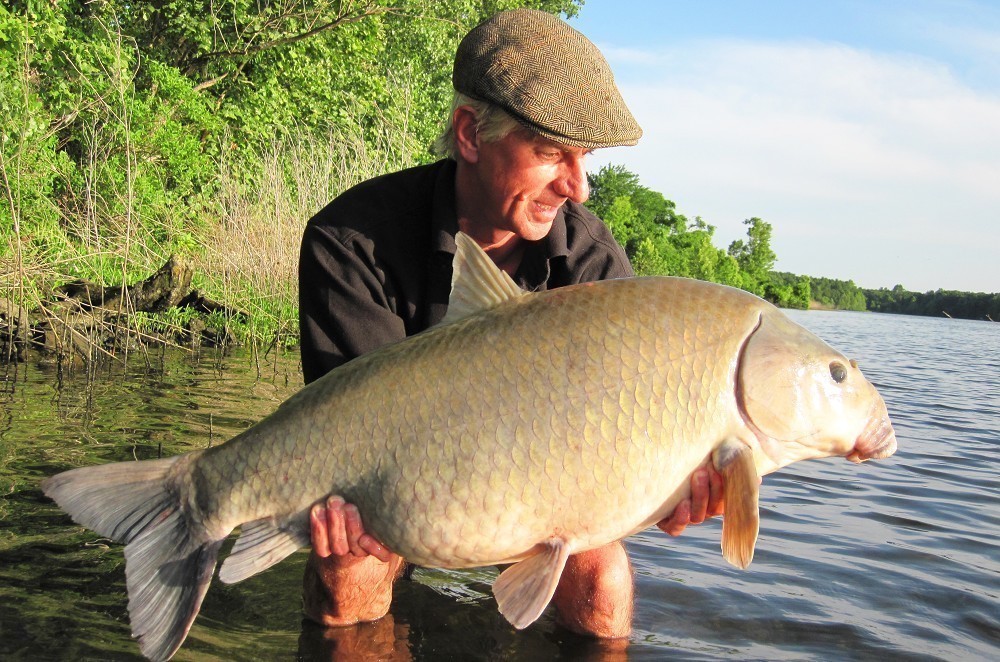 Not a carp, not even of the carp family, this is a ‘smallmouth Buffalo’, a uniquely North American native that grows to more than 60lbs and succumbs to conventional carp tactics.
Not a carp, not even of the carp family, this is a ‘smallmouth Buffalo’, a uniquely North American native that grows to more than 60lbs and succumbs to conventional carp tactics.IS: My advice is, do your research and make contact with local anglers. It can save you a lot of headaches and expense! Time of year, transporting tackle (importing bait can lead to confiscation and possibly a fine) are key considerations. You’ll often find the local contacts you make might even be prepared to lend items that you may need (bivvies, bedchairs etc). CAG & the British Carp Society have an informal agreement to help one another’s members.
CLfA: Related to this of course is the general future of carp fishing in America. How do you see fishing for carp here in the next five, ten, twenty years?
IS: There is no doubt that carp fishing in North America is healthier than ever. CAG has seen it’s Facebook membership and paid membership grow significantly in the past year alone. I certainly hope in 25 years from now when CAG celebrates its 50th anniversary that carp will have become recognized as a true sport fish in most if not all US states and that we see all trophy carp routinely released to grow even bigger.
CLfA: Finally, looking to the future of your own personal carp fishing: do you have any particular targets you've set for yourself, a certain size of fish to catch, a special water to fish?
IS: Over the years I’ve caught a lot of commons on the fly but a mirror had eluded me. So I recently went to Blackfoot reservoir Idaho while I was in nearby Jackson Hole and ticked that one off my bucket list. A USA 50 is still a goal (46.04 is my biggest USA carp to date), as well as a fish over 30Kg, which is why I’m headed back to Parco in Italy in September. But most of all it is to keep on carp fishing and to enjoy every moment I get to be by the water.
CLfA: Iain, many thanks for taking part.





